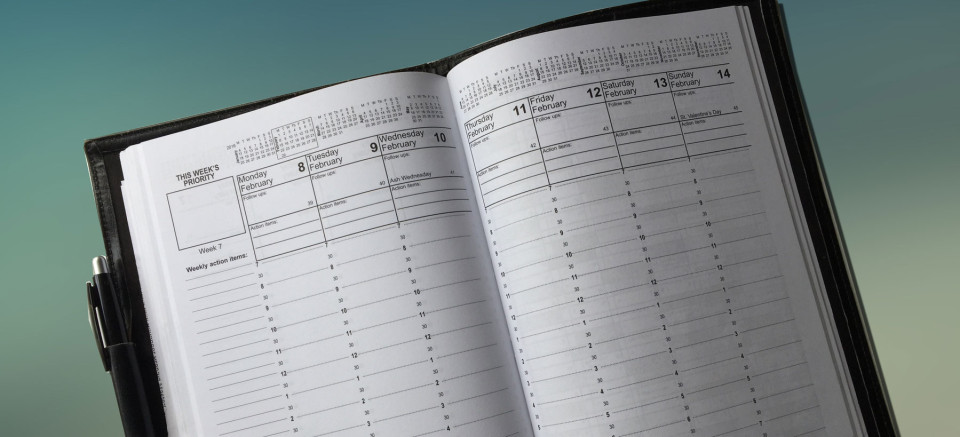
A merging of high-tech and high-touch
Hand-held electronic computers can boost productivity immensely. But they are computers, not planners. Don’t throw away the kitchen sink just because you buy a dishwasher.
With a hard copy planner you can see your entire week, complete with scheduled tasks and your “things to do” list at a single glance. Flipping of a page brings you a whole new week of plans, appointments and projects. You can see your activities take shape, become completed and remain visibly intact as permanent trophies to your weekly accomplishments. A hardcopy planner also serves as a journal, reflecting not only your past activities, but your uniqueness – taking on your personality, character, and philosophy. It reveals your habits and style as well as your priorities. Color coding, sticky notes, self-adhesive labels and hand written notes can form a permanent footprint of your presence in this world and the impact you made.
Nobody wants to be left behind in this information age where technology is king; but it’s not a case of either using an electronic handheld device or using a paper planner. They both have their place. You can continue to plan and schedule using a paper planner while using your handheld device for contact information, databases, electronic communications, Internet access, and the dozens of other functions used on a regular basis such as GPS, photography, ebooks, email, banking and Google searches.
As the article titled “The Upgrade Game” in the June, 2015 issue of Scientific American claims, “No tech company would create a product just once, designed perfectly for its task, and just sell the version forever with, making only compatibility tweaks as necessary.”
But that’s exactly what we have done with the Taylor Planner – designed over 30 years ago, and only tweaked as necessary based on feedback from its users. It won’t turn on your TV set, provide directions to the nearest shopping mall or search the Internet. It does one thing only, and does it well – helps you to plan your days and weeks so you get the important things done while keeping your life in balance. No upgrades necessary.
According to the Scientific American article mentioned above, since Word was distributed in the 1980s, they have offered upgraded versions 14 times, and if you bought Photoshop in 1990 and bought all the upgrades, you would have paid over $4,000 by now.
I try not to compare a paper planner with a handheld computer because they are not even in the same league. A paper planner plans, it doesn’t compute. But just be aware that the electronic gadgets will continue to add new features whether you need them or even want them. And eventually your older model won’t even be supported by the newer operating systems. But what really bothers me from a time management perspective is that the planner portion of an electronic device is becoming lost among the myriad of other features.
And what bothers me even more is the truth of the statement made by David Pogue, the anchor columnist for Yahoo Tech, and author of the Scientific American article: “Each time (that you upgrade) you lose a few days of productivity as you learn the new layout.”
Balancing high-tech with high- touch can strengthen our brain-based “executive skills, and technology writer Danny O’Brien, who interviewed top achievers, found one thing in common that may account for their increased productivity. They all used some sort low-tech tool, such as a written “To Do” list or a plain paper pad.
The Caveman Principle, as explained by Michio Kaku, professor of theoretical physics at the City College and City University of New York, says that given a choice between high-tech and high-touch, we opt for high-touch every time. For example, would you rather see a celebrity performer sing at a concert or watch a DVD of the same performance? Or how about a live sporting even vs. a re-run on TV?
In addition to the planner I use a hard copy Telephone & E-mail Log in which to make notes when I talk to people on the telephone or review my email. I find more people are using this as we get further into the digital age – probably because it prevents multitasking while on the telephone, improves concentration, shows co-workers you are actually busy and not available to them, and most important, insures that you don’t forget all the things that require follow-up as you switch from call to call and from one email message to another. And it’s like a breath of fresh air to your overloaded brain.
I’m not advocating a return to paperwork; but I do advocate the merging of high-tech and high-touch. There is no need to apologize for using paperwork when it actually serves you better and improves your efficiency. It’s even more important to have an organized mind than an organized working environment – although they do complement each other.
Some predictions about the future have been proven wrong – such as the “paperless office.” There is actually more paper since the advent of computers. People trust concrete evidence more than they do electrons on a computer screen that disappear when you turn off the screen. That’s probably another reason I still prefer to use a paper planner.
It doesn’t have to be a planner. Some people are being so rapidly bombarded by instant tasks, requests and assignments that they find it literally impossible to schedule much of anything in a planner. For those people we have designed a Priority Planner Pad – a one-page system that accommodates the hectic lifestyle of someone constantly on the move. You can view them both at our website, taylorintime.com.


Recent Comments